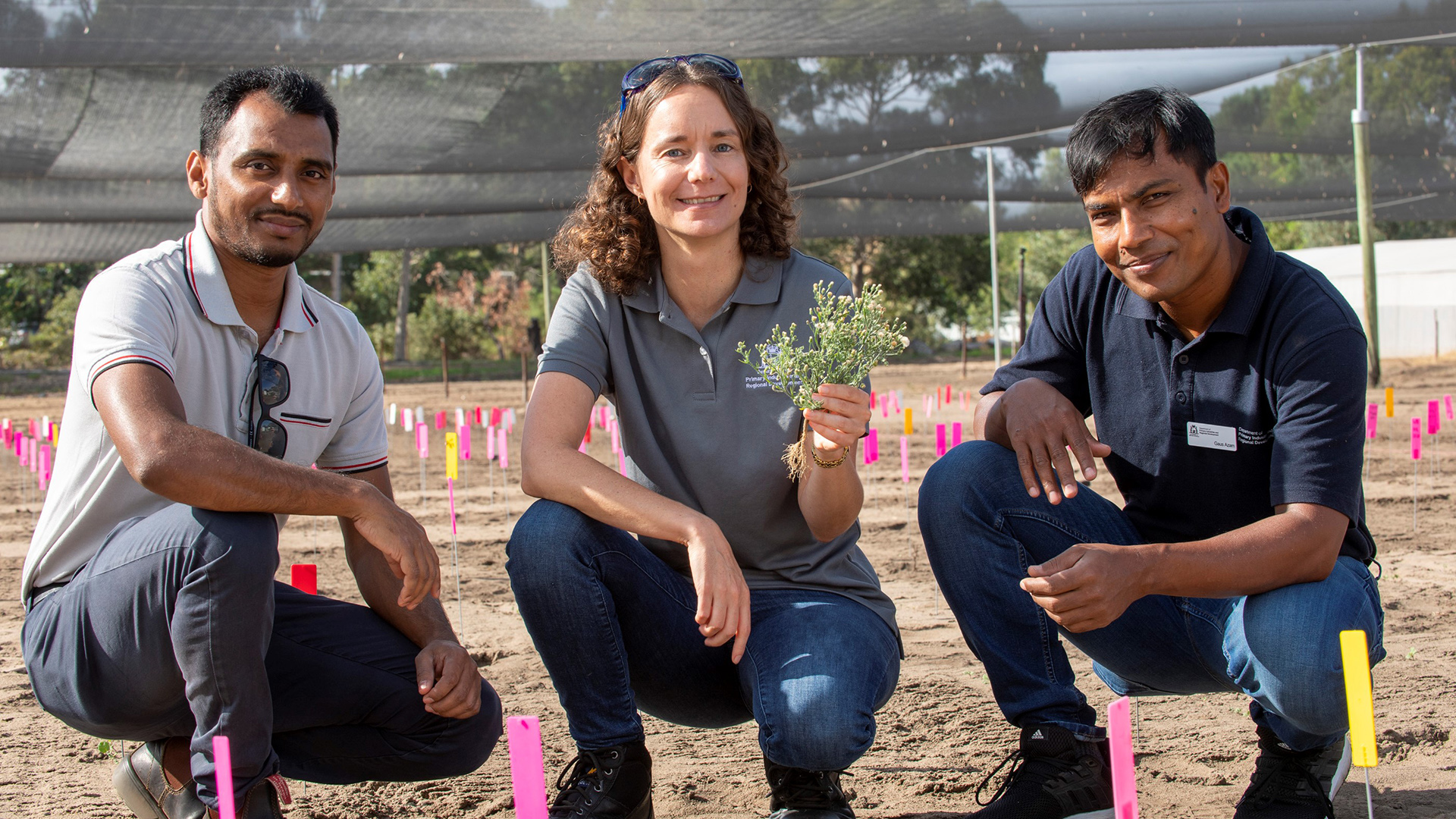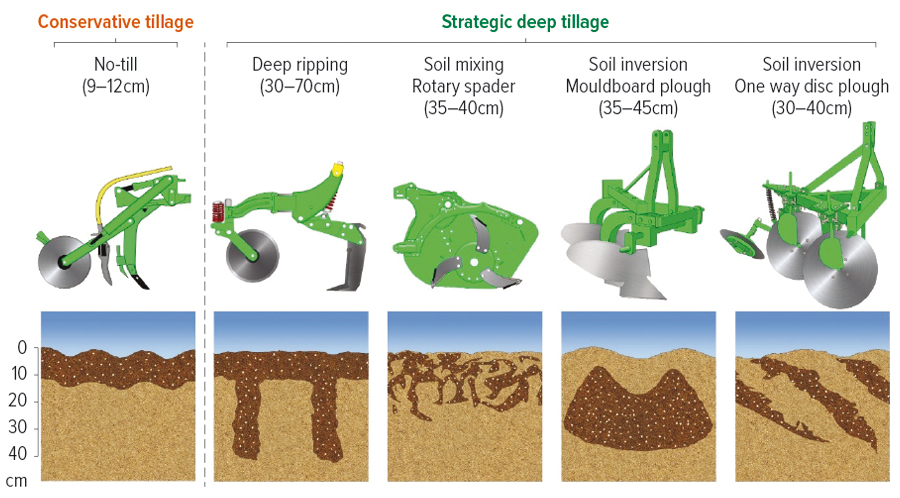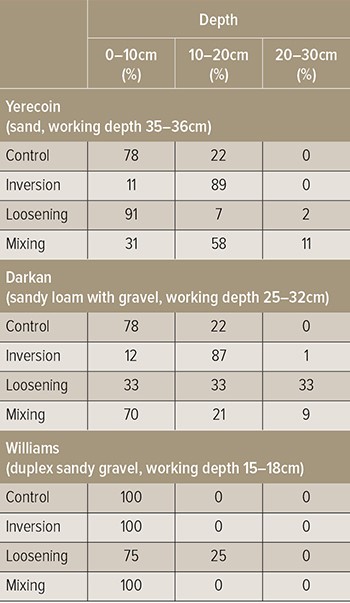Check list
To ensure the optimal crop establishment and weed management strategy with strategic deep tillage, the following check list provides recommendations for growers.
Before strategic deep tillage:
- Thoroughly test soils to depth to identify all production constraints and estimate how strategic deep tillage will change the topsoil (in terms of clay content, organic carbon).
- Clearly define the constraints you are targeting, what machinery and depth of tillage will work best and what the risks and limitations are.
- Identify weed species and densities and use this to estimate the likely weed pressure post-strategic deep tillage. Consider what depth each weed species will emerge from.
Tillage event:
- Aim to undertake tillage when there is good soil moisture. This will improve the depth of weed burial and reduce the risk of erosion and furrow infill.
- Select an appropriate pre-emergent herbicide with good crop safety. It should not be sensitive to changes in organic matter or the amount of crop residue on the surface, and not reliant on separation from the crop to ensure safety.
- Establish a vigorous cereal crop as soon as possible to mitigate acute erosion risk and maximise crop competitiveness with weeds. Increased seeding rates, one-pass amelioration and seeding approaches can be useful strategies to improve crop establishment. Use of long-coleoptile wheats, large seed with high germination percentage and higher-protein seed also help to ensure even crop establishment.
Post-tillage:
- Assess weed densities, and whether the dominant weeds have changed so that you can best design future herbicide strategies and use the best post-emergent herbicides available for the target weed.
- Check the sandiest parts of the paddock for any possible instances of crop damage from herbicide. Use these observations to change future herbicide strategies as needed.
- Even if weed density is reduced through amelioration, use an integrated weed management program (in-crop control and harvest weed seed control) to maintain weeds at low density.
Western Australian growers have become increasingly adept in their means of ameliorating the constrained soils that they crop, often achieving large productivity gains.
Altered soil conditions from amelioration techniques such as strategic deep tillage can improve crop emergence and growth, increasing competitiveness with weeds. However, this change can also alter the frequency and density of weed species and how the crop and weeds respond to pre-seeding herbicides.
The GRDC project ‘Increasing farming system profitability and longevity of benefits following soil amelioration’, led by Department of Primary Industries and Regional Development (DPIRD) senior research scientist Dr Stephen Davies, involves a program on crop establishment addressed by Tom Edwards. This project has collaborated closely with the DPIRD-funded project ‘Impact of soil amelioration on weed ecology and control’, led by department research scientist Dr Catherine Borger.
Where do the weed seeds go?
The main impact of strategic deep tillage on weed seeds is seed burial, Dr Borger says.
“This can influence weed emergence and be a means of physically controlling weeds, but may also affect pre-emergent herbicide efficacy and crop-weed competition,” she says.
Dr Borger’s team has undertaken field work at Yerecoin (sand), Darkan (sandy loam with gravel) and Williams (duplex sandy soil) using three amelioration treatments: loosening (using deep ripping), deep mixing (rotary spader or disc ploughs) and inversion (mouldboard), along with a no-till control for comparison.

Dr Catherine Borger has investigated the impact of strategic deep tillage on weed ecology with Dr sultan Mia (left) and Dr Gaus Azam (right). Photo: Peter Maloney, DPIRD
Figure 1 shows the action of some of the common implements used in soil amelioration and the way in which weed seeds may be buried at depth. Table 1 shows the results of weed seed burial by the three different tillage techniques in different soil types from the field trials.
Figure 1: Variation in weed seed burial at depth resulting from a range of deep tillage methods.

Source: Mia, S.M., Azam, G., Nouraei, S. and Borger, C. (2023) Strategic tillage in Australian conservation agricultural systems to address soil constraints: how does it impact weed management? Weed Research 63, 12-26. https://doi.org/10.1111/wre.12564
Each weed species has a different seed bank ecology and could respond differently to the depth at which it is buried. For example, small-seeded ryegrass might be effectively managed by burying to depth of greater than five centimetres, but larger-seeded great brome grass might be able to germinate and emerge from up to 15cm depth.
“These ecological factors of different weed seeds are important to understand when considering the potential role and consequences of using strategic tillage,” Dr Borger says.
“This means that growers need to identify the problem weed seeds in their cropping systems together with the density of these seeds. Our field trial work showed very variable results for the three types of soil amelioration intervention.
Table 1: Percentage of weed seeds at various depths at three contrasting WA sites using three methods of soil amelioration.

Source: DPIRD
“We found that soil inversion was highly effective in reducing weed density (by 90 to 100 per cent compared to control) in the year following strategic tillage, but large-seeded great brome recovered and returned faster than small-seeded ryegrass. The impact of soil loosening or mixing on weed emergence was highly variable, depending on soil type, the implement used and depth of mixing achieved.
“Moreover, emergence of buried seeds collected from varying soil depths indicated that deep mixing by either a rotary spader or disc plough distributed weed seeds throughout the soil profile to the full depth of tillage, whereas soil inversion by a mouldboard plough buried most weed seed to half the maximum working depth.”
But Dr Borger says the research does give good insights into weeds’ response to soil amelioration, which can help inform weed management strategies following amelioration.
What happens to herbicides?
Tom Edwards says that by 2020 the adoption of strategic deep tillage as a means of soil amelioration had occurred across approximately 2.25 million hectares in WA.
“Strategic deep tillage can result in quite dramatic changes to drive crop productivity, and our work is focused on optimising agronomy to sustain these changes post-amelioration,” he says.
“One concern we have learnt from growers has been about the observed herbicide damage to crops post-amelioration and many growers are changing their herbicide strategy post-amelioration.”
To support growers in making these decisions, Mr Edward’s team has undertaken 13 field trials (from Geraldton to Esperance) and six intensive screenhouse experiments with a range of commonly used pre-emergent herbicides.
“We are finding that the burial of soil organic matter, removal of stubble, changes in topsoil clay content and changes to the soil surface brought about by amelioration methods can change the biological availability of soil-applied herbicides,” Mr Edwards says.
“These issues are particularly relevant for sandy soils, which have low organic matter levels and are prime candidates for soil amelioration. However, amelioration can improve some aspects of weed management – for example, crop competition with weeds; more-even germination of weeds can mean improved herbicide efficacy.
“And deep tillage techniques such as the use of mouldboard ploughs for soil inversion can actually directly reduce weed seed background numbers through deeper burial.”
To optimise integrated weed management strategies following strategic deep tillage, Mr Edwards anticipates that through a better understanding of how the herbicides behave in these soils the project will be able to help growers select the best herbicide strategy for their soil type post-strategic deep tillage.
“Before implementing strategic deep tillage, growers should consider to what degree they will change their risk of herbicide damage and the species and density of weeds present. With this information, we can help growers mitigate the risk of crop damage while ensuring they continue to drive down weed numbers.”
Table 2 shows an example of a risk matrix for weed management and herbicide application in soils following strategic deep tillage, which is under construction from the findings of this research.
Table 2: Proposed risk matrix for weed management and herbicide application in ameliorated soils. The final version is subject to further research, which could change or refine this information.

Source: DPIRD
Catherine Borger, catherine.borger@dpird.wa.gov.au; Tom Edwards, tom.edwards@dpird.wa.gov.au

























































